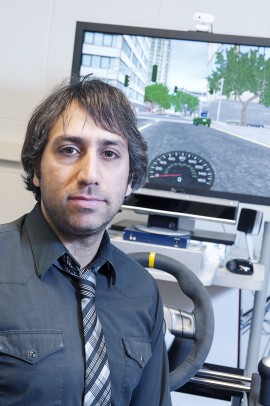Research would prevent drivers from falling asleep at the wheel

Jonathan Waxman, an M.D./Ph.D. candidate, studies the effects of sleep deprivation on driving. “Sleep apnea means you’re more likely to have car accidents,” he says. Photo: Roberta Dupuis-Devlin/UIC Photo Services
Suppose you have a sleeping disorder that results in driving drowsy — wouldn’t it be nice if a device could alert you before you crash?
Jonathan Waxman is working on that.
The M.D./Ph.D. candidate has been in the lab studying the effects of sleep deprivation on driving behavior, and what to do about it.
“If you suffer from sleep apnea, during the day you’re likely to fall asleep and have cognitive deficits and memory problems,” Waxman said. “Sleep apnea means you’re more likely to have car accidents.”
In the sleep lab, researchers worked with people who have sleep apnea and normal folks who were forced to stay up for 24 hours.
In a dark room, they watched on-the-road scenes with one finger poised on a button. Every three seconds a white circle would appear, the signal to press the button.
“People who were deprived missed more of the button pushes,” Waxman said. “We’re trying to develop a way of predicting when this will happen, with people hooked up to sensors to check the brain, heart and breathing.”
Working with Linda Laatsch, director of rehabilitation psychology in the College of Medicine, and Jason Leigh, former director of the Electronic Visualization Laboratory in the College of Engineering, Waxman developed two very different driving simulations.
One was rural, a monotonous straight road through cornfields guaranteed to make your eyelids droop. The other was urban, a mazelike route with frequent turns demanding your wide-awake attention.
Subjects sat in a mockup car cockpit equipped with steering wheel and gas and brake pedals, “driving” for four half-hour sessions. “If they hit a boundary, feedback would push them back into line and wake them up. It also measured speed and lane usage,” Waxman said.
Working with him were two advisers, David Carley, director of the Center for Narcolepsy, Sleep and Health Research, a joint effort of the colleges of Nursing and Medicine, and Daniel Graupe, emeritus professor of electrical and computer engineering.
“We definitely had some success with accident predictions,” Waxman said. “Now we’re trying to get patents on some of this technology.”
A device using this technology could help prevent accidents by those in high-risk occupations such as truckers or train operators. Carmakers could make the devices standard or optional equipment, he said.
When it comes to this kind of safety tech, “the first thing you think of is a rumble strip by the side of the road,” he said. “That’s detecting at the last second, a little better than an airbag. But car companies are trying to go another step — detecting the drowsy state.”
That information, though, could come too late. Prediction of drowsiness would be preferable, perhaps through subtle changes in breathing or heart rate, Waxman said.
“Can we measure physiological information?” Waxman asked. “Like a sensor on the body or something non-contact, a camera that looks at your face and by its color change detects heart rate.”
“After I leave, Dr. Carley and colleagues will be working on a commercializable prototype that will include my prediction technology,” he said.
Waxman was born in New York City but grew up in Freehold, N.J. His bachelor’s degree is from the University of Pennsylvania, where he studied computer science engineering.
His Ph.D. will be in electrical and computer engineering — an unusual combination with medical studies, he said. “I don’t think there is anyone who has done it at UIC.”
When he started medical school, he thought he would become a psychiatrist. “I was interested in mathematical analysis of physiological data,” he said.
Then he met Carley, a world expert in sleep apnea and breathing, and “we kind of hit it off.” And when it came to picking a department for his Ph.D., “electrical engineering fit better” than bioengineering.
Waxman graduates next month and heads for a residency at Wayne State University in Detroit in otolaryngology.
“I want to be a head and neck surgeon, and part of that involves treating people with sleep apnea, medically or surgically,” he said. “And I’d like to continue doing research on sleep and sleep apnea.”
Waxman lives in Noble Square, near Ashland and Chicago, in an apartment where he made much of the furniture himself. “My dad was a shop teacher,” he noted.
The Centers for Disease Control and Prevention and the Institute of Medicine identify sleep disorders as a public health crisis, he said.
“The CDC says people sleep less than they’re supposed to; up to 40 percent sleep less than 7 to 8 hours a night,” he said.
In his own case, Waxman tries to sleep seven to eight hours. “It’s partly because I’m studying this kind of stuff,” he said. “And I feel better.”
